Face/s
A face is a bounded surface: a bounded region in a network, or on a three-dimensional shape or object. See also: adjacent, polyhedron.
Factor
A factor (number) is a natural number that divides exactly into another given natural number. For example, 2 is a factor of 12, since ![]() . More generally, a factor (algebraic) of a given algebraic expression is a number or algebraic term that divides exactly into the given expression. For example, the factors of the linear expression
. More generally, a factor (algebraic) of a given algebraic expression is a number or algebraic term that divides exactly into the given expression. For example, the factors of the linear expression ![]() are 3 and
are 3 and ![]() since
since ![]() . Similarly,
. Similarly, ![]() and
and ![]() are factors of
are factors of
![]() since
since ![]() .
.
The set of all factors of a given number is called its factor set. The factor set of 12 is {1, 2, 3, 4, 6, 12}. The elements of a factor set are often grouped in pairs. Thus, the set of factor pairs of 12 is {{1, 12}, {2, 6}, {3, 4}, {4, 3}, {6, 2}, {12, 1}}.
A prime factor of a natural number ![]() is a factor of
is a factor of ![]() that is a prime number, for example, the prime factors of
that is a prime number, for example, the prime factors of ![]() are {2, 3, 5, 11}. Prime factors can be found using a factor tree.
are {2, 3, 5, 11}. Prime factors can be found using a factor tree.
See also: divisible, factor tree.
Factor tree
A factor tree breaks down a number into its prime factors. An example of a possible factor tree for the number 18 is shown below (prime factors occur at the end of each branch):
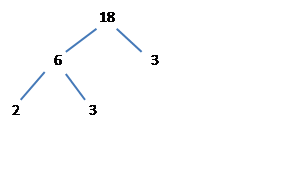
It can be seen from the factor tree that the prime factorisation of ![]() .
.
See also: factor
Factor set
See: factor.
Factorial
![]() factorial (written
factorial (written ![]() is the number formed by the product of a given natural number with all the natural numbers less than it. For example, to find the value for 4 factorial we have
is the number formed by the product of a given natural number with all the natural numbers less than it. For example, to find the value for 4 factorial we have
4! = 4 × 3 × 2 × 1 = 24. In general, for ![]() factorial:
factorial:
![]()
Factorise
To factorise a number or algebraic expression is to express it as a product of simpler terms.
For example, ![]() ,
, ![]() and
and ![]() .
.
Finite
The set {a , b , c , d , e} is an example of a finite set. The set of all people alive on a given day is a very large, but finite set. The cardinal number of a finite set is a natural number, that is, the elements of any finite set can be put in a one-to-one correspondence with the elements of a set of the form {0, 1, 2, 3, ... , n } where n is a natural number.
Five-number summary
A five-number-summary is a method for summarising a data set using five statistics: the minimum value, the lower quartile ![]() , the median
, the median ![]() , the upper quartile
, the upper quartile ![]() and the maximum value.
and the maximum value.
For example, for the set of data {2, 3, 4, 5, 6, 10, 12}, we have: median = 5, ![]() ,
, ![]() , maximum = 12 and minimum = 2. See also: box-and-whisker plot, interquartile range, range.
, maximum = 12 and minimum = 2. See also: box-and-whisker plot, interquartile range, range.
Flowchart
A flowchart is a diagram which shows a sequence of steps (may be used to represent an algorithm). The flowchart below shows a process of classifying numbers as even or odd:
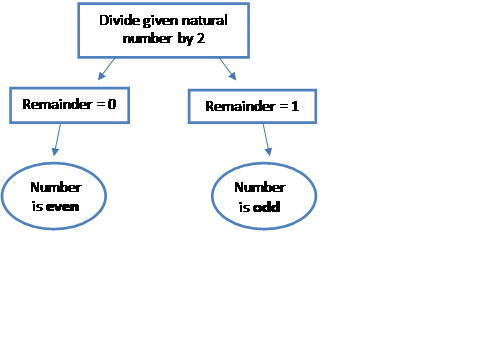
Formal unit
A unit whose value is fixed by agreement is a formal unit. For example, the litre is a formal unit of capacity for fluids, and the hour is a formal unit of time.
Fraction
A fraction is a number of the form ![]() where
where ![]() is an integer and
is an integer and ![]() is a non-zero integer. If
is a non-zero integer. If ![]() and
and ![]() are both positive integers, a fraction can be modelled by dividing a unit length into
are both positive integers, a fraction can be modelled by dividing a unit length into ![]() equal parts and collecting
equal parts and collecting ![]() multiples of these parts. For example,
multiples of these parts. For example, ![]() refers to 3 of 5 equal parts of the whole, taken together.
refers to 3 of 5 equal parts of the whole, taken together.
For the fraction ![]()
![]() is called the numerator and
is called the numerator and ![]() is called the denominator. The horizontal line separating the numerator from the denominator is called the vinculum. Sometimes a fraction is written on a single line as
is called the denominator. The horizontal line separating the numerator from the denominator is called the vinculum. Sometimes a fraction is written on a single line as ![]() /
/![]() in which case the diagonal line is referred to as a solidus.
in which case the diagonal line is referred to as a solidus.
A fraction ![]() is said to be a proper fraction if
is said to be a proper fraction if ![]() and an improper fraction otherwise. For example,
and an improper fraction otherwise. For example, ![]() is a proper fraction while
is a proper fraction while ![]() is an improper fraction.
is an improper fraction.
A fraction is said to be expressed in simplest form if its numerator and denominator have no common factor other than 1. For example,![]() is expressed in simplest form (because the highest common factor of 3 and 5 is 1), but
is expressed in simplest form (because the highest common factor of 3 and 5 is 1), but ![]() is not in simplest form, since 3 is a common factor of both 6 and 12, as is 6 (the hcf).
is not in simplest form, since 3 is a common factor of both 6 and 12, as is 6 (the hcf). ![]() would be expressed in simplest form as
would be expressed in simplest form as ![]() .
.
The rules for the algebraic combination of fractions are given by
See also: highest common factor, rational number.
Frequency
Frequency, or observed frequency, is the number of times that a particular value occurs in a data set. For grouped data, it is the number of observations that lie in that group or class interval.
Relative frequency is given by the ratio ![]() , where
, where ![]() is the frequency of occurrence of a particular data value or group of data values in a data set and
is the frequency of occurrence of a particular data value or group of data values in a data set and![]() is the number of data values in the data set.
is the number of data values in the data set.
An expected frequency is the number of times that a particular event is expected to occur when a chance experiment is repeated a number of times. If the experiment is repeated ![]() times, and on each of those times the probability that the event occurs is
times, and on each of those times the probability that the event occurs is ![]() , then the expected frequency of the event is
, then the expected frequency of the event is ![]() . For example, suppose that a fair coin is tossed 5 times and the number of heads showing recorded. Then the expected frequency of ‘heads’ is 5/2 since
. For example, suppose that a fair coin is tossed 5 times and the number of heads showing recorded. Then the expected frequency of ‘heads’ is 5/2 since ![]() . This example shows that the expected frequency is not necessarily an observed frequency, which in this case is one of the numbers 0, 1, 2, 3, 4 or 5.
. This example shows that the expected frequency is not necessarily an observed frequency, which in this case is one of the numbers 0, 1, 2, 3, 4 or 5.
See also: frequency distribution, frequency table.
Frequency distribution
A frequency distribution is the division of a set of observations into a number of classes, together with a listing of the number of observations (the frequency) in that class.
Frequency distributions can be displayed in tabular or graphical form.
Frequency table
A frequency table lists the frequency (number of occurrences) of observations in different ranges, called class intervals. The frequency distribution of the heights (in cm) of a sample of 42 people is displayed in the frequency table below:
Height (cm) |
|
Class interval |
Frequency |
155 - <160 |
3 |
160 - <165 |
2 |
165 - <170 |
9 |
170 - <175 |
7 |
175 - <180 |
10 |
180 - <185 |
5 |
185 - <190 |
5 |
185 - <190 |
5 |
Notice that the class intervals do not overlap (so the number 160, for example, is only counted in one class, not two). The data in this frequency table could be represented by a histogram.
A two-way frequency table is commonly used for displaying the two-way frequency distribution that arises when a group of individuals or things are categorised according to two criteria.
For example, the two-way table below displays the two-way frequency distribution that arises when 27 children are categorised according to hair type (straight or curly) and hair colour (red, brown, blonde, black) could be below (also recording gender):
Hair colour |
Hair type |
Total |
|
Straight |
Curly |
||
Red |
1 |
1 |
2 |
Brown |
8 |
4 |
12 |
Blonde |
1 |
3 |
4 |
Black |
7 |
2 |
9 |
Total |
17 |
10 |
27 |
We can see, for example, that there are 2 students with red hair (1 straight and 1 curly) and 12 students with brown hair (8 straight and 4 curly).
The information in a two-way frequency table can also be displayed graphically using a side-by-side column graph.
See also: histogram, side-by-side column graph.
Function
A function is a correspondence (map or relation) between the elements of two sets where each element in the first set is mapped to exactly one corresponding element in the second set. A function is either a one-to-one correspondence or a many-to-one correspondence.
The functions most commonly encountered in elementary mathematics are real functions of real variables. For such functions, the domain and co-domain are sets of real numbers.
Functions are usually defined by a formula for ![]() in terms of
in terms of ![]() . For example, the formula
. For example, the formula ![]() , defines the ‘squaring function’ that maps each real number
, defines the ‘squaring function’ that maps each real number ![]() to its square
to its square ![]() .
.
Functions, broadly speaking, have two types of variables:
See also: correspondence, domain, range, variable.
Function machine
A function machine is an algorithmic process which takes an input, applies an operation (or operations) and results in an output. A simple diagrammatical representation is below:

Input |
Output |
0 |
3 |
1 |
5 |
2 |
7 |
3 |
9 |
4 |
11 |
For example, a function machine and an accompanying table of values could be:
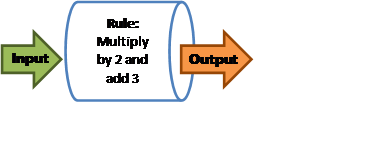
This could be represented by the rule ![]() where
where ![]() is the input and
is the input and ![]() the output.
the output.
See also: function, inverse machine.
G
Golden ratio (phi, j)
Consider two quantities ![]() and
and ![]() , where
, where ![]() . The golden ratio (represented by the Greek letter phi j ) is the irrational number whose value is given by the proportion when the ratio of the two quantities
. The golden ratio (represented by the Greek letter phi j ) is the irrational number whose value is given by the proportion when the ratio of the two quantities ![]() is the same as the ratio of their sum
is the same as the ratio of their sum ![]() to the larger of the two quantities, that is
to the larger of the two quantities, that is![]()
![]()
This can be shown geometrically in the figure below. The golden ratio is given by the proportion AC : AB = AB : BC where A and C are the endpoints of a line segment and B is the point on the line segment between A and C such that AC : AB = AB : BC.

It is called the golden ratio as it is believed to represent a proportion of lengths that is aesthetically attractive to the human eye in art and design contexts. It also appears in some patterns in nature. The exact value of j is j = ![]() and its approximate value is 1.618 correct to 3 decimal places.
and its approximate value is 1.618 correct to 3 decimal places.
The decimal expansion for j to 100 significant figures is:
1.618033988749894848204586834365638117720309179805762862135448622705260462818902449707207204189391137.
The digits in this decimal expansion do not display any recurring pattern, a property which distinguishes irrational numbers from rational numbers. See also: irrational numbers.
Gradient
If ![]() and points
and points ![]() are points in the plane where
are points in the plane where ![]() –
– ![]() ≠ 0, the gradient of the line segment (interval) AB is given by
≠ 0, the gradient of the line segment (interval) AB is given by
AB = ![]() =
= ![]()
This is illustrated in the diagram below:
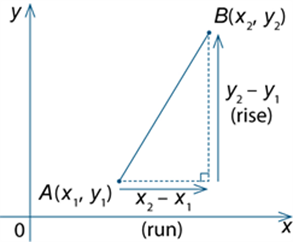
The gradient of a line is the gradient of any line segment that the line contains.
See also: line, line segment.
Graph
A graph is a visual representation of data or functions. Cartesian graphs of functions and relations are plots of ordered pairs of values (![]() ) that represent the function, or relation, relative to the
) that represent the function, or relation, relative to the ![]() and
and ![]() coordinate axes and the fixed origin (0, 0). Statistical graphs include dot plots, box and whisker plots, bar graphs and histograms. See also: Cartesian coordinate system.
coordinate axes and the fixed origin (0, 0). Statistical graphs include dot plots, box and whisker plots, bar graphs and histograms. See also: Cartesian coordinate system.
Greatest common divisor (gcd)
See: highest common factor.
Greatest common divisor (gcf)
See: highest common factor.
Grid reference
Most commonly used to refer to the alpha-numeric coordinates used to locate a position on a grid or map. In the grid below, Tarneit is found at grid reference B4.
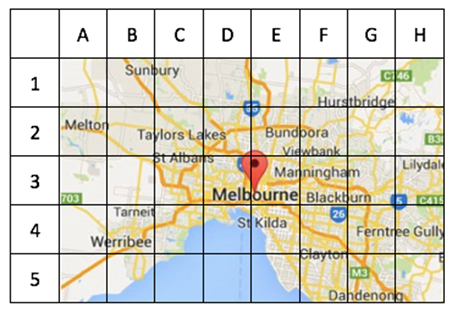
Map image from: Google Maps
H
Heuristic
The word heuristic comes from the Greek verb meaning ‘to discover’. In mathematics, an heuristic technique (often shorted to heuristic) refers to any of a number of different ways to go about solving a problem, learning and discovering. Heuristics can refer to the study or practice of these methods.
Highest common factor (hcf)
Also called the greatest common divisor (gcd) or greatest common factor (gcf), the highest common factor (hcf) of a given set of natural numbers is the common divisor of the set that is greater than each of the other common divisors. For example, since ![]() and
and ![]() are the common factors of 24, 54 and 66, this means that 6 is the highest common factor.
are the common factors of 24, 54 and 66, this means that 6 is the highest common factor.
Any fraction can be expressed in simplest terms by dividing its numerator and denominator by their highest common factor. See also: fraction.
Source: https://victoriancurriculum.vcaa.vic.edu.au/LearningArea/LoadFile?learningArea=mathematics&subject=mathematics&name=Mathematics%20Glossary.docx&storage=Glossary
Web site to visit:ttps://victoriancurriculum.vcaa.vic.edu.au
Author of the text: indicated on the source document of the above text
If you are the author of the text above and you not agree to share your knowledge for teaching, research, scholarship (for fair use as indicated in the United States copyrigh low) please send us an e-mail and we will remove your text quickly. Fair use is a limitation and exception to the exclusive right granted by copyright law to the author of a creative work. In United States copyright law, fair use is a doctrine that permits limited use of copyrighted material without acquiring permission from the rights holders. Examples of fair use include commentary, search engines, criticism, news reporting, research, teaching, library archiving and scholarship. It provides for the legal, unlicensed citation or incorporation of copyrighted material in another author's work under a four-factor balancing test. (source: http://en.wikipedia.org/wiki/Fair_use)
The information of medicine and health contained in the site are of a general nature and purpose which is purely informative and for this reason may not replace in any case, the council of a doctor or a qualified entity legally to the profession.
The texts are the property of their respective authors and we thank them for giving us the opportunity to share for free to students, teachers and users of the Web their texts will used only for illustrative educational and scientific purposes only.
All the information in our site are given for nonprofit educational purposes